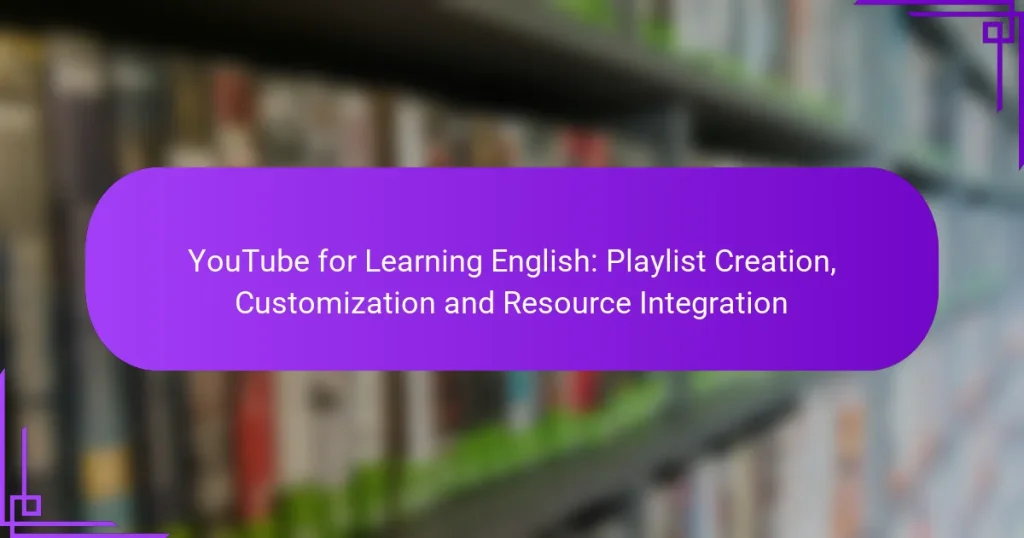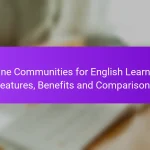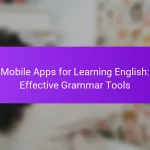YouTube offers a dynamic platform for learning English through the creation of tailored playlists that cater to various language skills and proficiency levels. By customizing these playlists with engaging thumbnails and clear descriptions, learners can navigate content more effectively. Additionally, integrating supplementary resources enhances the educational experience, providing valuable materials that complement the video lessons.

How to create effective YouTube playlists for learning English?
Creating effective YouTube playlists for learning English involves curating a selection of videos that cater to various language skills and levels. A well-structured playlist can enhance the learning experience by providing organized content that is easy to follow and engaging.
Step-by-step playlist creation
To create a YouTube playlist, start by signing into your YouTube account and navigating to the video you want to add. Click on the ‘Save’ button below the video, then select ‘Create new playlist’ or add it to an existing one. Name your playlist something descriptive, like “English Grammar Basics” or “Conversational English Practice.”
After creating the playlist, continue adding relevant videos that align with your learning goals. Aim for a mix of content types, such as tutorials, conversations, and quizzes, to keep the learning process dynamic and engaging.
Best practices for organization
Organizing your playlist effectively is crucial for maximizing learning. Group videos by themes or topics, such as vocabulary, pronunciation, or idioms. This allows learners to focus on specific areas of interest or need.
Consider the order of videos as well. Start with foundational concepts before progressing to more complex topics. A logical flow helps learners build on their knowledge incrementally, making it easier to grasp new concepts.
Utilizing YouTube features
YouTube offers several features that can enhance your playlists. Use the ‘Add a description’ field to provide context for each playlist, outlining what learners can expect. This can guide users in selecting playlists that suit their needs.
Additionally, consider using the ‘Collaborate’ feature to invite others to contribute videos. This can enrich the playlist with diverse perspectives and resources. Finally, regularly update your playlists to include new content and remove outdated videos, ensuring that learners always have access to the best resources available.

What customization options enhance learning?
Customizing your YouTube playlists can significantly improve the learning experience for English language learners. Key options include creating engaging thumbnails and providing clear descriptions, both of which help attract and inform viewers.
Custom thumbnails for engagement
Custom thumbnails are vital for grabbing attention and encouraging clicks on your playlist. A well-designed thumbnail should visually represent the content and include relevant imagery or text that resonates with learners.
Consider using bright colors and bold fonts to make your thumbnails stand out. For example, a thumbnail featuring a smiling person with the text “Learn English Fast!” can be more appealing than a generic image. Aim for a resolution of 1280 x 720 pixels for optimal quality.
Playlist descriptions for clarity
Clear and concise playlist descriptions help learners understand what to expect from the content. A good description should summarize the playlist’s focus, highlight key topics, and mention the intended audience, such as beginners or advanced speakers.
For instance, a description like “This playlist covers essential vocabulary for everyday conversations, perfect for beginners” provides immediate context. Keep descriptions under 200 words to maintain clarity and engagement.

How to integrate resources with YouTube playlists?
Integrating resources with YouTube playlists enhances the learning experience by providing additional materials that complement video content. This can involve linking to external websites, documents, or other media that support the topics covered in the videos.
Linking external resources
Linking external resources involves adding URLs to relevant websites or documents within your YouTube playlist description or individual video descriptions. This allows learners to access supplementary information, such as articles, exercises, or interactive tools that reinforce the video content.
When selecting external resources, ensure they are reputable and directly related to the topics discussed in your videos. For example, if a video covers English grammar, linking to a well-known grammar website can provide viewers with additional practice and explanations.
Using supplementary materials
Supplementary materials can include PDFs, slides, or worksheets that enhance the learning process. These materials can be uploaded to platforms like Google Drive or Dropbox, and links can be shared in the video descriptions or comments section.
Consider creating a structured approach to your supplementary materials, such as organizing them by topic or difficulty level. This helps learners easily find the resources they need. For instance, if your playlist covers vocabulary, you might include flashcards or quizzes to reinforce learning.

What are the benefits of using YouTube for learning English?
YouTube offers numerous advantages for learning English, including access to a vast array of resources and the ability to engage with content in an interactive way. These benefits make it an effective tool for learners at various levels, enhancing both comprehension and retention.
Accessibility of diverse content
YouTube provides learners with access to a wide range of English language content, from educational channels to entertainment. This diversity allows users to choose materials that align with their interests, such as cooking shows, travel vlogs, or language tutorials, making learning more enjoyable.
Additionally, many videos come with subtitles, which can aid comprehension and help learners connect spoken and written language. This feature is especially beneficial for non-native speakers who may struggle with pronunciation or slang.
Engagement through multimedia
The multimedia nature of YouTube content—combining visuals, audio, and text—enhances engagement and aids memory retention. Learners can see and hear language in context, which helps them understand usage and nuances more effectively than traditional methods.
Moreover, interactive elements such as comments and community discussions allow learners to practice their English skills in real-time. Engaging with other viewers or creators can provide practical language practice and foster a sense of community among learners.
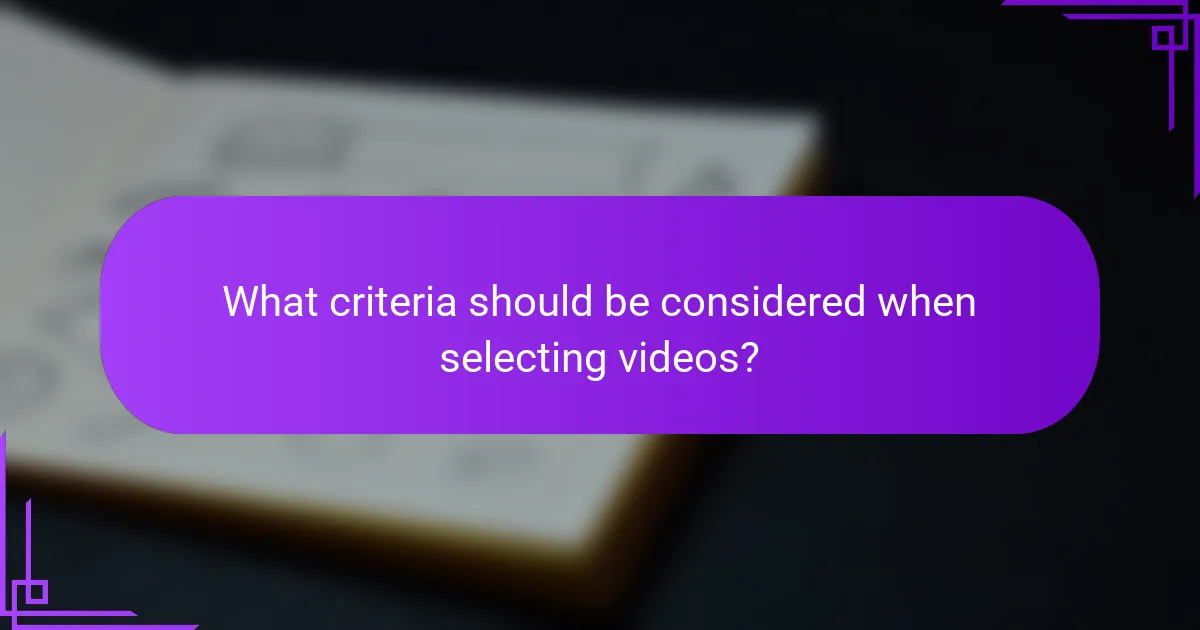
What criteria should be considered when selecting videos?
When selecting videos for learning English, it’s essential to consider factors like relevance to your learning objectives and the quality of the video presentation. These criteria ensure that the content is both educational and engaging, enhancing the overall learning experience.
Relevance to learning objectives
Choosing videos that align with your specific learning goals is crucial. For instance, if your aim is to improve conversational skills, look for videos that focus on dialogues or real-life scenarios. Consider the language level of the content; beginner, intermediate, or advanced, to match your proficiency.
Additionally, assess whether the video covers topics that interest you or are necessary for your studies. This relevance can significantly boost motivation and retention. A good practice is to create a checklist of your learning objectives and evaluate each video against these criteria.
Video quality and presentation
The quality of the video and its presentation style can greatly impact your learning. High-definition visuals and clear audio are essential for understanding spoken English. Look for videos that use subtitles, as they can help reinforce vocabulary and pronunciation.
Moreover, consider the presenter’s delivery style. Engaging and dynamic presenters can make the content more enjoyable and easier to follow. Avoid videos that are overly long or poorly structured, as they may lead to disengagement. Aim for videos that are concise, ideally between 5 to 15 minutes, to maintain focus and interest.

How to evaluate the effectiveness of your playlists?
To evaluate the effectiveness of your playlists, focus on learner feedback and viewer engagement metrics. These two aspects provide insights into how well your content meets the needs of learners and how actively they are interacting with the material.
Feedback from learners
Gathering feedback from learners is crucial for assessing playlist effectiveness. You can use surveys, comment sections, or direct conversations to understand their experiences and preferences. Ask specific questions about what they liked, what could be improved, and how the content helped them in learning English.
Consider implementing a rating system for each video in the playlist. This allows learners to express their opinions quickly and helps you identify which videos resonate most with your audience. Regularly reviewing this feedback will guide you in making necessary adjustments to enhance the learning experience.
Tracking viewer engagement metrics
Monitoring viewer engagement metrics is essential for evaluating how well your playlists are performing. Key metrics include watch time, average view duration, and retention rates. High retention rates indicate that learners find the content engaging and relevant, while low rates may suggest the need for content adjustments.
Utilize YouTube Analytics to track these metrics effectively. Look for trends over time to see if changes you make to the playlist lead to improved engagement. For example, if a specific video consistently has low watch time, consider revising its content or format to better capture learner interest.
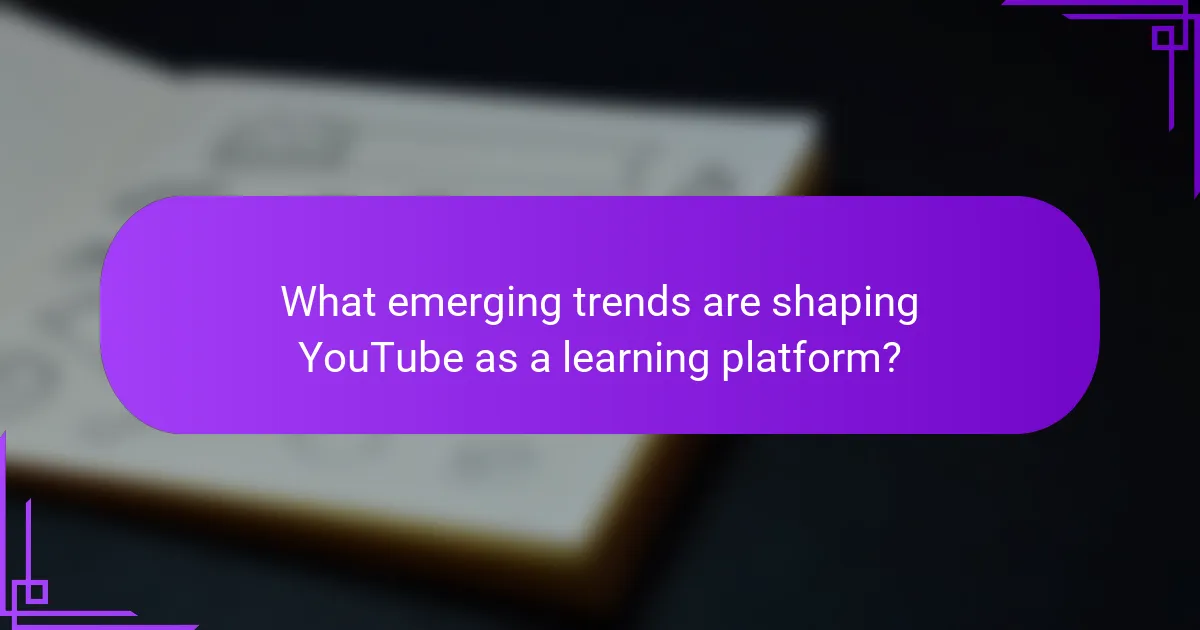
What emerging trends are shaping YouTube as a learning platform?
YouTube is increasingly recognized as a powerful tool for learning, driven by trends such as personalized content, interactive features, and community engagement. These elements enhance the educational experience, making it more accessible and tailored to individual needs.
Personalized Learning Experiences
Personalized learning on YouTube allows users to tailor their educational journeys based on interests and proficiency levels. Algorithms suggest videos that align with viewers’ previous interactions, making it easier to find relevant content. This customization can significantly enhance motivation and retention.
Creators can also develop playlists that cater to specific learning objectives, such as grammar, vocabulary, or pronunciation. By organizing content in a structured way, learners can progress through topics at their own pace, reinforcing their understanding as they go.
Interactive Features and Engagement
YouTube’s interactive features, such as polls, quizzes, and comment sections, foster engagement and active participation. These tools encourage learners to reflect on their understanding and connect with others, creating a sense of community. Engaging with peers can enhance the learning process and provide additional support.
Creators can utilize these features to create more dynamic lessons. For instance, incorporating quizzes into videos can help assess comprehension in real-time, allowing learners to identify areas needing improvement immediately.
Integration with Other Learning Resources
YouTube can be effectively integrated with other educational resources, such as online courses, e-books, and language learning apps. This integration allows learners to access a variety of materials that complement video content, providing a more holistic approach to language acquisition.
For example, a learner might watch a YouTube video on English idioms and then practice using those idioms through an interactive app. This combination reinforces learning and helps solidify new concepts in practical contexts.
